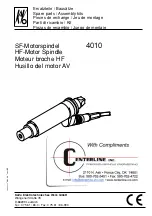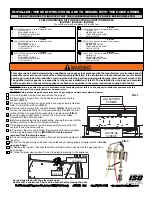
ENGLISH
– In the operating mode with current output, the device delivers an output current of either 4...20 mA.
This device is not a transmitter.
– The air quality signal “good“...“bad“ is represented by the output signal 4...20 mA or 0...10 V (selectable via DIP).
– The chemical sensor is a consumable.
The lifetime of the sensor depends on nature and concentration of the pollutant gas burden.
– This device may only be used in non-precipitating air without above-atmospheric or below-atmospheric pressure at the sensor element.
– The voltage output is short-circuit proof.
– Applying overvoltage will destroy the device.
– In case of pollution, we recommend cleaning and recalibration in the factory.
– The device operating range covers 10...95 % relative humidity respectively 0...+50 °C.
Outside of that range, mismeasurements or increased deviations will occur.
– If this device is operated beyond the specified range, all warranty claims are forfeited.
Air quality is measured through a chemical sensor. Due to its functional principle, the lifetime of the sensor depends on nature and concentration of
the pollutant gas burden. The sensitive layer of the sensor element reacts with all volatile organic compounds and is thereby modified in its electrical
properties or “exhausted“. This process results in a displacement of the characteristic curve. Such characteristic curve displacement however amounts
to less than 15 % ⁄ year under normal burden. In measuring air quality, the general condition of air quality is detected. Whether air quality is “good“ or
“bad“ is differently interpreted by each person.
Different pollution burdens and concentrations influence the air quality signal (0...10 Volt) in different ways. Examples for this are cigarette smoke,
deodorant sprays, cleaning agents, or also various adhesive materials for floor and wall coverings as well as dyestuffs. Increased burdens e.g. by solvents,
nicotine, hydrocarbons, aerosol propellants etc. intensify consumption ⁄ aging of the sensor element. Particularly under high pollutant gas burdens – also
during non-operational idle state periods of the devices (transport and storage) – zero-point drift will occur. Consequently, this must be corrected at site
according to the respective circumstances or basic burdens.
Air quality measuring instruments of different manufacturers cannot directly be compared because of different functional principles, preset basic burdens
(zero-point), and permitted burdens (amplification ⁄ sensitivity). Devices are preset respectively calibrated according to the sensor manufacturer‘s specifi-
cations. Here, a zero-point and a final value is determined and thus a maximum burden. In particular cases, exceeding measuring ranges or excessive basic
burdens on the devices will occur (outgassing floor carpeting, wall paint, etc.). In order to enable distinguishing different air qualities, devices need to be
adjusted by the customer according to the conditions existing on site that do not correlate to the factory-preset definition range and calibration. Please
note that factory calibration is thereby lost and compliance with technical data can no longer be guaranteed.
ATTENTION!
There is no universally uniform standard, which could be applied to a
VOC sensor
(Volatile Organic Compounds). The monitored air contains a large number of
substances to which the sensor responds, and gas mixtures are adjusted. Therefore this sensor does not act selectively, but rather reflects the overall air
quality. In principle, one also cannot state precisely what is "bad air" or what is "good air" because this is a purely subjective sensation.
The gas inter-exchange in the sensor element happens by diffusion. Depending on the changes to the concentration and the flow velocity of the air surrounding the
sensor, the reaction of the device to the change of concentration may take place with a delay. It is essential to choose an installation location for the device in
which the air stream flows around the sensor. Otherwise the gas exchange may be considerably delayed or prevented.
Automatic calibration of air quality (default)
The automatic background logic is a self-calibrating mechanism that is suitable for use in applications in which the air quality regularly drops to fresh air level.
This should typically occur during times in which the rooms are unoccupied. The sensor reaches its normal accuracy after 24 hours of continuous operation in an
environment that has been subjected to a fresh air supply . The deviation errors remain minimal if the sensor is exposed to fresh air at least 4 times within 28
days. The ABC logic needs continuous operating cycles of more than 24 hours to operate correctly.
Manual calibration of air quality
After connecting the device, ensure continuous operation for at least 2 hours using air defined as "normal" air quality.
Manual calibration can be started by pressing the DIP 3 button, irrespective of the DIP3 switch status.
The calibration procedure is started by pressing the "ZERO" button (for approx. five seconds). This is signalled via the flashing LED.
Then calibration takes place. During this phase, the LED is continuously active and a 600 second countdown runs.
Putting in operation
After switching on the device, a self-test and tempering period follows. This process takes around 30 - 50 minutes, depending on the ambient conditions.
It is imperative to perform manual calibration once this process is completed. The ABC logic can then be optionally activated.
Switching point setting
A switching point between 10 % and 95 % of the measuring range can be selected using the SET potentiometer.
A potential-free changeover contact is available as a switch output.
Offset
The VOC measured value can be adjusted subsequently using the offset potentiometer.
The adjusting range is ± 10 % of the measuring range.
Notes regarding DPWQ 306000 and DPDQ 306000


























